Undergraduate Research
Developing the 21st century skills of problem-solving, imagination, critical and creative thinking, collaboration, communication and ethical reasoning and mindset requires the right blend of training and opportunity. What is the best way to prepare for the future? In the UAB Department of Physics, our hands-on research projects and faculty expertise let students pursue highly sought-after experiences in materials science, lasers and photonics, computation and high-tech instrumentation. These experiences are now critical for all STEMM fields and 21st century jobs while also helping educate the whole person.
High-level research conducted by UAB’s Department of Physics directly involves students in our B.S. degree and Honors programs. By working in faculty research labs, publishing peer-reviewed manuscripts, and giving conference presentations, students are able to enjoy educational experiences that extend beyond the classroom. This opportunity allows our students to develop advanced skills that are critical in a global, technology-driven economy and gives them a competitive edge over their peers.
The problems addressed by physics research are complex. You know where you want to go, but you don’t know how to get there. This requires skills such as imagination, resilience, and the ability to break down a complex problem into manageable parts. All our areas of research focus place an emphasis on excellence and on using critical thinking and systematic analysis to understand complex theories and solve today's scientific problems. Students become well-connected to industry, with well-developed skills that prepare them very well to serve a fast-changing and technology-driven society.
All research courses require submission of a form and departmental approval. To begin the process, contact Undergraduate Program Director Dr. Renato Camata and/or your physics professors for referrals and potential mentors. In addition, students can register for course credit for their research activities. Learn more about our research courses in the UAB Undergraduate Catalog. Also, consider our new Accelerated Bachelors/Masters (ABM) degree on Research-Intensive Physics.
Research Experiences for Undergraduates (REU)
Our REUs make a significant contribution to ongoing research on a wide range of research topics. For more information, please see the REU website.
Here are some of our recent participants and what they have to say about our program:
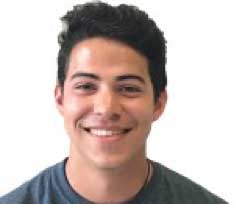
Nicolas Merino placed 1st in the Physical and Applied Sciences category at the 2017 Summer Expo. Nicolas presented a poster entitled “Theranostic Systems of Polymers and Tannic acid for Ultrasound Therapy Drug."
“My work with microcapsules has been in depth and shows promise for making noteworthy progress. By using polyethyleneimine (PEI), poly(N-vinylpyrrolidone) (PVPON), and TA, we can make loaded or unloaded microcapsules. What makes these capsules unique in comparison to other drug delivery vehicles is their ability to be imaged and precisely delivered at tumor sites, for example. Using ultrasound imaging technology, our microcapsules generate enough contrast because of the rigidity of the PVPON/TA bilayers, and the difference of environment inside and outside of the capsules. Further plans include fundamental studies of ultrasound imaging on PVPON/TA bilayers. In my timeat UAB, I learned to make these microcapsules and have even fabricated Doxorubicin (Dox) loaded microcapsules which will be administered to mice. Dox is a well-known chemotherapy drug with harmful side effects, particularly to cardiovascular tissue. Our dox loaded capsules were given to a collaborator who will inject them into mice and study the effects of dox loaded capsules on the heart tissue. We hope that our encapsulation prevents any dox release resulting in unaffected cardiovascular tissue.”
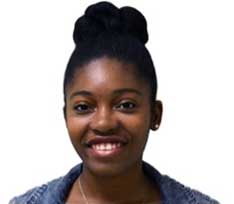
Sherilynn Knight placed 2nd in the Engineering category for her project "Retrieval Analyses of Wear and Debris in Oxidized Zirconium Total Knee Arthroplasty.
“The goal of this project was to analyze the micromotion, score and characterize wear, and cellular response of eight knee replacement systems. These systems, each from eight different patients contain a tibial component made from polyethylene and a femoral component (or femoral head) made from zirconium oxide, a material nearly as hard as diamonds. Some of the systems approximately 4-5) include patellas (knee caps) that also have polyethylene glued to the back of them. Polyethylene is a very common type of plastic that has been used traditionally through all types of arthroplasty (knee, ankle, and hip). Because polyethylene is white, it’s very easy to see the extent of damage on the tibial component. On the other hand, the black zirconium oxide, is very difficult to see.”
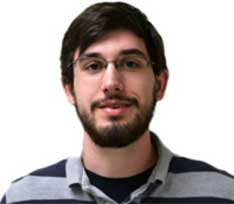
Brandon Scoggins’ project focused on Computational Materials research.
“We primarily focused on the Crystal Field Effect perturbation term under Octahedral symmetry. This has involved doing many derivations of perturbation potentials and their effects on the states. After confirming that my results were correct, I designed a program to create Gaunt Coefficient tables based on orbital inputs. Gaunt Coefficients are constants that are associated with the integral over all space of the product of three spherical harmonic wavefunctions. These terms are used to define each element of a matrix that is used to determine the perturbation of the atom in question. The coefficients can be used to quickly determine the matrix elements of a perturbation potential, and the program and derivations can be generalized to accommodate any arrangement of particles.”
See presentations made by former REU students.
Learn more about Research Experiences for Undergraduates at UAB.
International Research Experience for Students (IRES): Nanofibrous Materials
This project started in 2013 and is now in its 2nd cycle. The program provides undergraduate and graduate students with unique hands-on experience in nanofibers and nanofibrous materials fabrication, structure analysis, properties testing, and applications.
Students obtain in-depth pre-trip training followed by intense summer research at the Technical University of Liberec (TUL), Czechia, and at the Lodz University of Technology (UT-Lodz), Poland. Many opportunities for enhancing the international cultural experiences are available through the great weekend adventures.
IRES participants are expected to and do present their work at various conferences and symposia and publish in refereed journals.
Here are some of our recent participants:
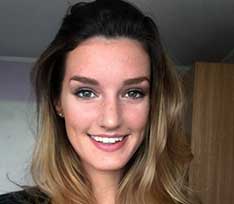
Ashlen Kurre, IRES’16 participant
Upon looking back at my undergraduate career, I can truly say that the IRES program was my favorite thing I participated in. During the summer of 2016, I had the opportunity to travel to the Czech Republic and perform research on AC electrospinning of nanofibers. I was granted plenty of independence in my research, which allowed me to develop important problem-solving skills necessary for my graduate school career and beyond. It was through the IRES that I solidified my goal for continuing my studies abroad, and I am now working towards my masters in physics in Berlin, Germany. Besides all the practical scientific knowledge I gained from the program, I also acquired priceless worldly awareness through being exposed to such a different culture, which I am endlessly thankful for; this cultural exposure made my transition to a new country much more familiar and enjoyable. Plus, the colleagues that attended the program with me became some of my best friends, and I know I will be able to count on them for the rest of my life. Overall, I am very appreciative to Dr. Stanishevsky and everyone involved with the IRES program for all that they have done for me.
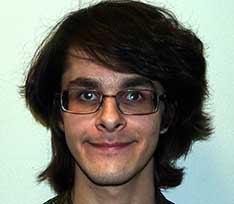
Justin Tchernov, IRES’17 participant
Beginning university as a chemistry major, I realized how the benefits of performing undergraduate research is imperative to gaining experience with a science background, along with securing any potential career-paths. As a first-generation immigrant of Russian and Ukrainian parents, having the opportunity to collaborate with Czech and Polish researchers in chemical physics sounded experiential to both my educational and cultural skills. My project is developing and electrospinning silica nanofibers, and my international research focused on using state-of-the-art analytical tools for characterization, along with application in catalysis. I have learned a great deal of techniques: using relatively simple equipment, like a refractometer and conductivity meter, engaging with more complicated machines, like an X-ray diffractometer, FTIR, TGA, rotational rheometer, and high-performance liquid-chromatography. Mixing solutions and electrospinning them into nanofibers is obviously fun to me as a chemistry major, but gaining hands-on experience with characterization made me realize how much more fun it is to understand what is happening and why. Working with our Czech and Polish partners and learning their diversity in both science and culture pushes me to continue my work in chemical physics, as it all seems beneficial towards a career involved in academic research.
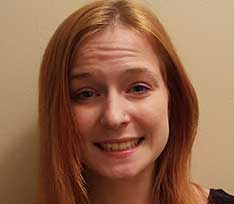
Riley Yager, IRES’17 participant
Initially, I had no idea what I was getting into when I applied for the IRES program. I saw the opportunity to travel the world and I decided I would try my luck. My interest in physics was only barely blooming at the time and I had very little knowledge of the research I would be doing. As my research progressed, my love for physics grew and I soon decided to pursue a second degree in physics alongside my environmental engineering degree. At first, I had no idea how my work with IRES and Dr. Stanishevsky could ever apply to what I wanted to do in life, but as learned more and more about the fundamentals of what I was researching it became very clear. My research included the fabrication, analysis of the composition, and mechanical properties study of zirconia nanofibers. The research of this material not only applies to my physics degree, but also has the potential to be applied environmentally which can play hand in hand with my engineering interest. All these amazing opportunities sprouted from participating in this wonderful program and I haven’t even included my magical experience overseas. I had the chance to work in the labs of two European universities and work side-by-side with people pursuing various goals. The experiences I had overseas were absolutely amazing and now I have friends and colleagues across the world and a new interest in world languages. I would recommend pursuing international studies to anyone in any field, and I can promise it will be lifechanging.
-
2017 Achievements
- September, 2017: Paper published: Katie Paulett*, Anthony Brayer*, Katrina Hatch*, T. Kalous, J. Sewell, T. Liavitskaya, S. Vyazovkin, F. Liu, D. Lukáš, A. Stanishevsky, Effect of nanocrystalline cellulose addition on needleless alternating current electrospinning and properties of nanofibrous polyacrylonitrile meshes, J. Appl. Polymer Sci., 134, 45772 (2017).
- April, 2017: Dr. Stanishevsky receives Provost’s Award for Faculty Excellence in Education Abroad.
*IRES students
-
2016 Achievements
- November, 2016: Katrina Hatch* wins the 1st place at the Fall UAB EXPO for the poster presentation on electrospun nanocellulose-based nanofibers.
- August, 2016: Paper published: A. Stanishevsky, Anthony Brayer*, P. Pokorny, T. Kalous, D. Lukas, Nanofibrous alumina structures fabricated using high-yield alternating current electrospinning, Ceramics International 42, 17154 (2016)
- May - July, 2016: IRES'16 team worked on new challenging projects at TUL and UT-Lodz.
- May, 2016: IRES 2015 results presented at NANOSMAT-USA: Katie Paulett*, Caitlin Lawson*, A. Saman, A. Stanishevsky, D. Lukas, Polysaccharide nanofibers by needleless electrospinning, 3rd NANOSMAT-USA, Arlington, TX, May 18-20, 2016.
- April, 2016: National Science Foundation (NSF) funded the proposal to continue this IRES project.
- March, 2016: Paper published: Caitlin Lawson*, A. Stanishevsky, M. Sivan, P. Pokorny, D. Lukas, Rapid fabrication of poly(e-caprolactone) fibers using needleless alternating current electrospinning, J. Appl. Polymer Sci. 133, 43232 (2016).
- January, 2016: IRES 2015 results presented at ICACC/16: A. Stanishevsky, Anthony Brayer*, P. Pokorny, D. Lukas. Ceramic Nanofibers and Porous Nanofibrous Structures by Electrospinning, ICACC 2016, January 24-29, 2016, Daytona Beach, FL.
*IRES students
-
2015 Achievements
- November, 2015: IRES 2015 results presented at MRS Fall'15: Muna Al-Safarjalani*, L. Blazkova, Emily Campbell*, Catherina Ritchey*, E. Kostakova, D. Lukas, A. Stanishevsky, Fabrication of biomedical natural and synthetic polymer nanofibrous naterials by electrocentrifugal spinning, MRS 2015 Fall Meeting, Boston, MA, 11/29-12/04, 2015.
- November, 2015: IRES 2015 results presented at MRS Fall'15: Caitlin Lawson*, M. Sivan, P. Pokorny, A. Stanishevsky, D. Lukas, PCL nanofibers for biomedical scaffolds by high-rate AC-electrospinning, MRS 2015 Fall Meeting, Boston, MA, 11/29-12/04, 2015.
*IRES students